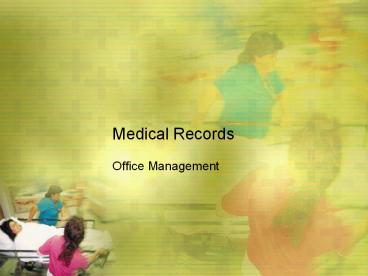Medical Records - PowerPoint PPT Presentation
1 / 18
Title:
Medical Records
Description:
Legibility of Medical Records. Records must be legible and able to be read by anyone. If legibility is a problem, then labels or stamps may be suggested for routine ... – PowerPoint PPT presentation
Number of Views:188
Avg rating:3.0/5.0
Title: Medical Records
1
Medical Records
- Office Management
2
Introduction
- Medical Record- a permanent written account of
the professional interaction and services
rendered in a valid patient-client relationship. - Some of most important documents in veterinary
medicine. - Medical record management is one of most
important tasks. - Purpose is to proved an accurate history for the
vet health team and the owner.
3
Types of Medical Records
- May be paper or computerized (paperless).
- Pros and cons to each system.
- Inactive records must be kept for a certain
length of time. - Copy of any written communication with owner must
be in the medical record (may be evidence). - Should be checked regularly for completeness.
- The more information that is available the better.
4
Legibility of Medical Records
- Records must be legible and able to be read by
anyone. - If legibility is a problem, then labels or stamps
may be suggested for routine procedures. - Correction fluid cannot be used on medical
record, release, or authorization form at any
time. - If mistake is made, make one line strike through
and initial.
5
Choosing a File System
- Filing by owners last name.
- Filing by client number.
- Color code system.
6
Paper Records
- Full Paper Records
- 8.5 x 11 inch paper and fastened into a file
folder with a 2 hole fastener. - Index Card Records
- 5 x 8 inch index cards
- Seem to be that team members write less on these
records. May be considered incomplete or
illegible.
7
Computerized Medical Records
- Filed in the computer by both client number and
last name. - Can be accessed by any computer and has all
records linked to the main patient file. - Must be secure, with access limited to authorized
individuals only. - Must be backed up daily and monthly, preferably
off-site. - Need back ups if computer become unavailable.
8
Medical Records Release
- Are confidential and can only be released when
the owner has given permission to do so. - Clients must sign a records release form which
must be kept in the record (includes release to
another veterinary clinic, boarding, grooming, or
new owner). - Clients may request a copy of their medical
records at any time.
9
Establishing a Medical Record
- Each patient must have their own medical record.
- Records must be easily able to be retrieved.
- Medical records must be complete and
well-organized (should follow SOAP format). - Records should be composed as legal documents
that can be admissible in court if needed. - Legibility of records is a must!
10
- Can have color coding to represent sex of
patient. - Can have numbers on outside representing year
which patient was last seen in order to purge
records more readily. - Can have cautions written on in colors or
highlighted on the actual chart.
11
What is included in a medical record?
- Client/Patient Information sheet.
- Previous Medical History.
- Vaccination History.
- The Primary Complaint.
- Physical Examination.
- Diagnosis and/or Possible Diagnosis.
- Laboratory Reports.
- Treatment
- Prognosis.
- Surgical Reports
- Estimates and Consent Forms
12
Taking A History
- All information the owner has presented must be
summarized in the medical record. - Very important component of not only a visit but
medical records as a whole.
13
Problem Oriented Medical Record (POMR)
- Most commonly in veterinary medical records
follow SOAP format. - SSubjective
- Reason for office visit
- OObjective
- Information gathered directly from the patient
- AAssessment
- Any conclusions reached from the subjective and
objective sections and includes a definitive
diagnosis (rule ins (R/I) or rule outs (R/O)) - PPlan
- Developed in according to assessment includes
treatment, surgery, medication, etc.
14
Accurately Recording
- Medication names, strengths, and route must be
accurately written in the medical records. - Example 0.2 ml cefazolin IV (is this right or
wrong?)
15
Herd Health Records
- Large animal veterinarians cannot have individual
records each food animal that they examine. - So record information for an entire herd,
including medications and vaccinations on one
record. - Individual records may be kept if surgical
procedures or special treatments are completed on
one animal.
16
Purging Medical Records
- Length of time a practice must keep an inactive
medical record varies state to state. - Most require it to be kept for 3 years but should
keep records on file from 3-7 years. - May have to arrange long term storage off site.
- Purged records should be shredded.
17
Client Discharge Instructions
- Very important!
- Should maybe have owner initial at bottom to
confirm receipt of information. - Different types of information may be required
for various patient discharges.
18
Radiographs
- If paperless, then radiographs can be stored
electronically. - Are property of the veterinary practice so log
whenever radiographs are leaving the clinic.

